Top Bewertungen
Jetzt kostenlosen Testzugang sichern Erst probieren, dann studieren!

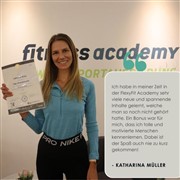
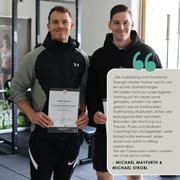



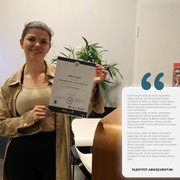
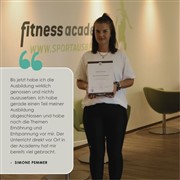

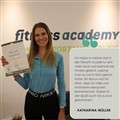
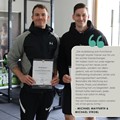
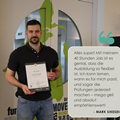

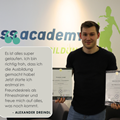

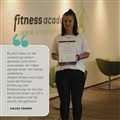

€ 2.890,- | Einzelunterricht
» UnsereLernpakete
Informationen zum Lehrgang
Anerkannt & Zertifiziert
Unsere Absolventen, Partner & Freunde sagen
Unser Team berät Sie gerne jederzeit per Telefon, Chat oder Persönlich
Der menschliche Körper ist ein Wunderwerk der Evolution. Einigen ist es jedoch nicht bewusst, wie anfällig unsere Wirbelsäule für Verletzungen ist. Rückenschmerzen zählen nicht ohne Grund zu den am weitest verbreiteten gesundheitlichen Problemen unserer Zeit.
Falsche körperliche Belastung, zu langes Sitzen, schlechte Körperhaltung und unergonomisches Arbeiten belastet unseren Rücken. Dadurch werden Flexibilität und Stabilität eingeschränkt, was in Folge zu muskulären Dysbalancen und Rückenschmerzen führen kann.
Als Wirbelsäulentrainer lernen Sie die vielfältigen Ursachen von Rückenproblemen kennen und welche funktionellen Übungen Sie zur Stabilisierung der Wirbelsäule einsetzen können. Mit diesem Wissen können Sie Ihren Kunden mit speziell auf Wirbelsäulentraing zugeschnittenen Personaltrainings helfen, Probleme mit der Wirbelsäule vorzubeugen und zu Langzeitfolgen zu vermeiden.
Wenn Sie Ihr Wissen um die Bereiche Entspannung und Ernährung erweitern möchten, dann bietet sich die höhere Ausbildung zum Dipl. Vital und Gesundheitstrainer an. Neben dem Wirbelsäulentrainer-Modul enthält dieser Lehrgang zusätzlich die beiden Ausbildungen Ernährungstrainer und Entspannungstrainer mit all deren top-aktuellen, lehrreichen Inhalten.
Starten Sie heute noch Ihre Karriere als Wirbelsäulentrainer!
Lernumfang
551 E
EQF-Level
Die Ausbildung orientiert sich an EQF-Level 4 »
Kursstart
Sofort möglich
Lernvariante
Einzelunterricht


Sind Rückenschmerzen, Verspannungen, Buckel oder Skoliose erst mal da, ist es nicht leicht, diese wieder in den Griff zu bekommen. Wirbelsäulentraining reicht daher von der Analyse und Prävention über Verbesserung von Beweglichkeit und Kraft bis zu Trainingseinheiten für Beschwerden. Kurzgesagt das Rundum-Paket für eine gesunde Wirbelsäule und einen gesunden Rücken!
Mit diesem Wissen können Sie auf Angestellten- oder freiberuflicher Basis Rückentrainingsstunden anbieten und individuelle Trainingspläne für Ihre Kunden erstellen. Außerdem können Sie Gesundheitspraxen, Kur- und Reha-Einrichtungen und auch Sport- und Wellnesshotels unterstützen.
Im Grundlagenmodul werden wir uns zunächst mit anatomischen, physiologischen und trainingswissenschaftlichen Grundlagen beschäftigen. Auch ernährungsspezifische Themen, Berufskunde und die erste Hilfe bei Sportverletzungen spielen eine wichtige Rolle in unserem Ausbildungsprogramm.
Wir zeigen Ihnen außerdem, wie Sie Trainingseinheiten für einen gesunden und starken Rücken gestalten können. Von den organisatorischen Rahmenbedingungen über didaktisch-methodischen Aspekte und natürlich dem notwendigen Fachwissen erfahren Sie in unserem Lehrgang alles, was Sie als Wirbelsäulentrainer brauchen.
Unsere Zertifikate sind weltweit gültig und werden in verschiedenen Varianten ausgestellt. Sie erhalten unser Zertifikat auf Wunsch in mehreren Sprachen (DE, EN, ES), mit länderspezifischen Informationen sowie mit und ohne Notendruck.
Diese Varianten sind alle kostenlos zum Download verfügbar. Zusätzlich erhalten Sie ein Zertifikat Ihrer Wahl gedruckt auf Sonderpapier mit Prägedruck.
Es wird folgende Urkunde (in mehren Sprachen DE, EN, ES) verliehen:
Wir freuen uns, Ihnen per Kontakt telefonisch, via E-Mail oder im Chat weiterhelfen zu können. Vielleicht finden Sie die Antwort auf Ihre Frage aber in unseren allgemeinen FAQ oder Wirbelsäulentrainer FAQ.
Lernumfang
200
Sportkompetenz
313
Präsenz | Selbstsstudium
6
Literaturrecherche
30
Praktische Umsetzung
2
Zusatzaufgaben & Prüfungen
Unsere Ausbildungen sind grundsätzlich förderfähig. Ob Ihnen eine Förderung genehmigt wird, entscheidet die jeweils zuständige Förderstelle.
Wir unterstützen Sie gerne bei der Zusammenstellung aller notwendigen Kursinformationen, die Sie für Ihren Förderantrag benötigen.
Selbstverständlich stehen wir Ihnen während des gesamten Prozesses beratend zur Seite und begleiten Sie von der ersten Anfrage bis zur Einreichung Ihres Antrags. Kontaktieren Sie uns - wir kümmern uns darum, dass Sie bestmöglich vorbereitet sind!
Alle Kapitel der Fächer anzeigen

Wir bilden die besten Trainerinnen und Trainer in der Fitnessbranche aus. Von Anfang bis zum Ende und darüber hinaus begleiten und betreuen wir unsere Absolventen/Innen.
Funktionelle Anatomie ist die Grundlage für jeden Trainer/jede Trainerin im Sport und Gesundheitsbereich. Mit diesem Fachkurs erhalten Sie einen umfassenden Einblick in die Anatomie des menschlichen Körpers und erwerben damit ein profundes Wissen.
Der Kurs wird so lebendig und verständlich wie möglich gestaltet, mit Hilfe verschiedener Lehr- und Lerntechniken - angepasst auf die Bedürfnisse von Fitness & PersonaltrainerIn.
Ziel ist es, die Zusammenhänge von Bewegungsabläufen zu erkennen und die wichtigsten lateinischen Fachausdrücke zu verstehen.

In der allgemeinen Sporternährung werden unsere Teilnehmer an die Grundzüge der Ernährung herangeführt.
Als Basis wird die Zusammensetzung unserer Ernährung mit Makro- und Mikronährstoffen, sowie der Wasserhaushalt besprochen. Um verschiedene Zusammenhänge zu verstehen, wird detailliert auf den Energiehaushalt eingegangen.
Des Weiteren wird die Wirkung der einzelnen Nahrungsbestandteile auf den menschlichen Körper, sowie deren Bedeutung im sportlichen Bereich besprochen.

Da im Sport Verletzungen an der Tagesordnung stehen, ist es wichtig, über die Ursachen und Folgen der häufigsten Verletzungen Bescheid zu wissen. Im Fall der Fälle muss der/die Personaltrainerin schnell und richtig reagieren können!
Außerdem hilft das Verständnis diverser Verletzungsbilder, diese bereits präventiv vermeiden zu können.

In vielen Unternehmen ist die betriebliche Gesundheitsförderung inzwischen eine beliebte Methode, um die Gesundheit der Mitarbeiterinnen und Mitarbeiter zu stärken, Krankheiten vorzubeugen und so das Wohlbefinden der Mitarbeiter zu stärken.
Warum betriebliche Gesundheitsförderung so wichtig ist, wird in einer Einführung in die betriebliche Gesundheitsförderung aufgezeigt, Herausforderungen der betrieblichen Gesundheitsförderung dargestellt und verbreitete Organisationskrankheiten besprochen.
Außerdem lernen die KursteilnehmerInnen, welche Erfolgsfaktoren der betrieblichen Gesundheitsförderung es gibt, welchen Nutzen die Beschäftigten und das Unternehmen daraus ziehen und natürlich bewährte Vorgehensweisen und Instrumente.
Dazu werden verschiedene Betätigungsfelder und Maßnahmen dazu vorgestellt und den Kursteilnehmern auch erklärt, wie man in solche Firmen kommt, Konzepte erstellt und andere wichtige organisatorische Dinge abklärt.
Die KursteilnehmerInnen bekommen Praktische Beispiele gezeigt und bekommen in dieser Einheit auch die Möglichkeit, das Gelernte in einer Gruppenarbeit anzuwenden.

Bei der Einheit Kundenorientiertes Arbeiten geht es darum, den KursteilnehmerInnen Einblicke in das Marketing zu geben, damit sie sich als Trainer/In später gut am Markt platzieren können und ihnen der Einstieg in den Markt erleichtert wird.
Dazu wird zuerst definiert, was Marketing überhaupt ist und weshalb es auch als PersonaltrainerIn seine Relevanz hat.
Außerdem werden gängige Fachbegriffe aus dem Marketing wie USP, Nutzen, Positionierung etc. und verschiedene Modelle des Marketings wie die SMART-Formel, der Marketingmix 4P und andere erklärt.
Auf die Kommunikation zwischen Trainer/In und Kunden/Innen wird in dieser Einheit natürlich nicht vergessen. Dazu werden verschiedene Aspekte der Kommunikation sowie Regeln für erfolgreiche Kommunikation eingeführt und Beispiele gezeigt.
Am Ende dieser Einheit sollten die KursteilnehmerInnen in der Lage sein, sich und ihr Produkt, die Dienstleistung, anhand einer Marketingstrategie am Markt zu positionieren und erfolgreich zu verkaufen.

Gute Kenntnisse der Physiologie des Menschen und die damit verbundenen Funktionen im Köper sind für alle im Sportbereich tätigen TrainerInnen eine notwendige Voraussetzung zur adäquaten Ausübung ihres Berufes.
Mit diesem Kurs werden Ihnen die Zusammenhänge des menschlichen Organismus "begreifbar" gemacht. Reisen Sie mit uns durch den menschlichen Körper und verstehen Sie die Funktionen des Organismus für Ihr neues Berufsbild im Sport.
Im Unterrichtsfach wird möglichst praxisnah und spannend die Energiebereitstellung des Muskels, das Herzkreislaufsystem und das Atmungssystem erkundet.
Eine gute Sport-Ausbildung beginnt an der Basis mit Anatomie und Physiologie.

In diesem Kurs werden die TeilnehmerInnen darauf vorbereitet, auf allen Ebenen mit dem Kunden/der Kundin erfolgreich kommunizieren zu können. Außerdem sollen dich die TeilnehmerInnen mit ihren eigenen Zielen und Motiven auseinanderzusetzen, um die der KundInnen besser verstehen zu können.
Das richtige Zielsetzung sowie korrektes Erteilen von Feedback sind ebenfalls Teile der Lehrveranstaltung!
Auch die Stressbewältigung und verschiedene Lernstrategien werden den Teilnehmenden näher gebracht, um diese nach der Ausbildung anwenden zu können.

Im ersten Teil der Trainingslehre werden die Grundlagen des Trainings, wie Trainingsprinzipien, Prinzipien der Trainingsgestaltung, Trainingsmethoden und die Faktoren der sportlichen Leistung vermittelt.
Da die Leistungsfähigkeit, Leistungsdiagnostik, Training und Wettkampf, in enger Wechselwirkung zueinander stehen, werden sie auch dementsprechend im Kurs unterrichtet.
Im zweiten Teil der Trainingslehre wird das Training als komplexer Handlungsprozess und im Zusammenhang mit Planung, Ausführung und Evaluation definiert und bewertet.
Ein wichtiger Teil der Trainingslehre ist nach wie vor die Trainingsplangestaltung, die mit Beispielen über die Möglichkeiten einer Trainingsplangestaltung praktisch vermittelt werden.
Um noch tiefer in die Trainingswissenschaft einzutauchen, haben wir mit internationalen Top-Referenten wie Prof. em. Dr. phil. Dr. med. Dr. h.c. Jürgen Weineck zusätzlich einen Video-Workshop zum Thema Höhentraining entwickelt.
Alle Kapitel der Fächer anzeigen



Die Einheit Grundlagen zum Thema starker Rücken liefert das theoretische Basiswissen zum/ zur Diplom WirbelsäulentrainerIn. Einleitend verschaffen wir uns einen Überblick über die Verbreitung von Rückenschmerzen in Österreich und welche volkswirtschaftlichen Auswirkungen diese mit sich bringen. In Folge dessen wird die Entstehung von Schmerz auf neurophysiologischer Ebene geklärt und welche Belastungen im Speziellen zu Rückenschmerzen beitragen können. Dazu werden unterschiedliche Interventionsmöglichkeiten betrachtet und hinsichtlich der Behandlungs- und Kosteneffektivität überprüft. Um die Entstehung von Rückenschmerzen zu verstehen und die richtigen Behandlungsmaßnahmen setzen zu können, darf die spezielle Anatomie der Wirbelsäule nicht fehlen. Dazu werden die Besonderheiten der Wirbelsäule, der Aufbau der Bandscheiben, die sichernden Bänder sowie das Zusammenspiel der Rumpfmuskulatur genauer betrachtet. Im Anschluss wird auf spezielle Pathologien näher eingegangen und unterschiedliche Krankheitsbilder mit Erklärungen und MRT- Aufnahmen näher erläutert. Zum Abschluss werden noch Gesundheitsmodelle vorgestellt, die zum Verständnis beitragen sollen, was Betroffene abhalten oder motivieren kann ihr Gesundheitsverhalten zu überdenken. Im kurzen praktischen Teil werden noch Selbsthilfemaßnahmen bei Schmerzen vorgestellt und durchgeführt.

Die Einheit Körperwahrnehmung und Körpererfahrung soll aufzeigen, wieso es als Trainerin oder Trainer wichtig ist, sich auch mit psychologischen Aspekten zu befassen, um kompetenter handeln zu können.
Besonderer Fokus wird in diesem Teil der Ausbildung auf die Wahrnehmung gelegt. Unterschiedliche Aspekte von Wahrnehmung werden betrachtet, verschiedene Systeme vorgestellt und Fachbegriffe eingeführt.
Ziel ist es, die Körperwahrnehmung im Rahmen der Rückenschule zu verbessern.
Sie befassen sich auch mit der Wahrnehmung und dem Erleben Ihres eigenen Körpers. Dazu erfahren Sie Methoden und Inhalte und erhalten wichtige Hinweise, bevor Sie das Gelernte dann an praktischen Beispielen üben.
Diese Beispiele befassen sich unter anderem mit den Bewegungsmöglichkeiten der Wirbelsäule, mit der Wahrnehmung verschiedener Atemräume, der Stabilität und vielem mehr.
Zu jeder praktischen Übung werden Anleitungen zur Durchführung, zu den Zielen der jeweiligen Übung sowie praktische Tipps gegeben.
Auch das Erleben von Bewegungsfreude wird im Rahmen der Einheit behandelt.

Neben den nötigen Trainierkompetenzen müssen auch noch eine Menge organisatorischer Hürden bis zu Konzeption und Durchführung einer Rückenstunde, überwunden werden. Ziel der Einheit ist die TeilnehmerInnen mit Themen wie Zielgruppenbestimmung, Kursdauer, Gruppengröße, Raum, Equipment oder Kosten bis hin zu didaktisch- methodischen Aspekten zur Kursgestaltung zu konfrontieren. Erst wenn diese grundlegenden Überlegungen geregelt sind, kann die Konzentration auf die Trainingseinheiten gelegt werden.
Die Planung einer Rückeneinheit bringt jede Menge Aspekte mit sich, die beachtet werden sollten. Zuerst muss ein klares Ziel definiert werden. Aus diesem wird die Einheit in seine einzelnen Teile Warmup, Hauptteil und Cooldown gegliedert. Gegebenenfalls muss auch Zeit für die Begrüßung, Übungserklärung und Reflexion eingeplant werden. Erst wenn die grobe Struktur steht, werden die Übungen ausgewählt und den jeweiligen Blöcken zugeordnet. Erst dann folgt der trainingswissenschaftliche Aspekt der Einheit, bestehend aus dem Bestimmen der Dauer, Intensität, Dichte und Umfang der Übungen. Natürlich muss all dies auf das Ziel und TeilnehmerInnen der Trainingseinheit zugeschnitten sein.
So haben die TeilnehmerInnen nach gemeinsamer Ausarbeitung der Inhalte die Aufgabe, zuerst ein Konzept zur Kursorganisation zu erstellen und in weiterer Folge Trainingseinheiten für unterschiedliche Zielgruppen bzw. Beschwerdebilder zu planen. Zum Abschluss werden die von den TeilnehmerInnen geplanten Einheiten vorgestellt und durchgeführt, sodass erste Erfahrungen im Anleiten und Korrigieren gesammelt werden können.

Der menschliche Körper ist ein komplexes System aus Muskeln, Sehnen, Gelenken und Knochen, das ständig in Bewegung ist.
Jede Bewegung setzt eine Reaktion in Gang, die sich auf andere Bereiche des Körpers auswirkt. Das sensomotorische Training ist eine Methode, die genau solche Reaktionsketten im Körper trainiert. Durch das gezielte Training der Sinne (wie z.B. Gleichgewichtssinn, Tastsinn, Seh- und Hörvermögen) und der Motorik (Muskelkraft, Koordination, Beweglichkeit) wird das Zusammenspiel von Körper und Geist verbessert.
Unter sensomotorischer Regulation versteht man die Fähigkeit des Gehirns, die Motorik und die Wahrnehmung zu steuern. Sensomotorisches Training stammt aus dem Bereich der Physiotherapie. Es hat zum Ziel, die sensomotorische Regulation zu trainieren und wird z.B. nach einem Schlaganfall eingesetzt. Es kann aber auch im Leistungssport und im Fitnessbereich eingesetzt werden, um die motorischen Fähigkeiten zu verbessern.
In diesem Fach wird die Sensomotorik für die Fitnesstrainer Ausbildung erarbeitet. Dabei werden praxisorientierte Kräftigungsübungen mit instabilen Unterlagen wie Wackelbrettern, Schaumstoffen, Gymnastikbällen, Seilen und Schlingen durchgeführt.
Das Training auf instabilen Oberflächen, wie z.B. der des BOSU Balls, schult die Propriozeption, also die Wahrnehmung des eigenen Körpers und seinen Bewegungen. Jede derartige Übung stellt eine Herausforderung für Gleichgewicht, Koordination und Kraft dar und ist somit besonders effektiv.



Verfügbare Lernvarianten dieser Ausbildung
Unterrichtssprache
Fachmodul
Sportkompetenz (Online)
Sportkompetenz (Präsenz)
Sportkompetenz Full HD LernVideos
Full HD Lernvideos Wirbelsäulentrainer
Fachmodul Full HD LernVideos Fitnesstrainer
Lernvariante
Lernmethode
auditiver & visueller Lerntyp
kommunikativer & motorischer Lerntyp
Lernzeit
Skripten & Unterlagen als PDF
Vorlesungen als Praxistage aufbuchbar
Support via Onlinecampus, eMail, Chat, Tel.
WhatsApp & vor Ort Support
Testprüfungen
NADA Austria
Höhentraining - Prof. DDDr. Weineck
SPK Zwischenprüfung Online
Abschlussprüfung
Zertifikat auf DE, EN, SP
Zertifikat weltweit & zeitlich unbegrenzt gültig
Onlinecampus lebenlang Verfügbar
Gratis Demokonto / Schnupper-Paket
Urkundenkopien als PDF downloadbar
Urkunden mit Echtheitsprüfung (QR-Code)
Fördermöglichkeiten
Bildungskarenz (AT)
Förderung f. Firmen
Förderung f. Selbständige
Lehrgangsberatung
Kostenvoranschlag f. Förderstelle
Jobvermittlung
umfangreiche Weiterbildungesangebote
Absoluter Bestpreis & Leistungsangebot
DE
Online + Fachgespräch
Optional aufbuchbar
314
120
online
visuell
empfohlen
geeignet
flexibel
aufbuchbar
flexibler Termin
bis zu 100%
unverbindlich
DE
Präsenzkurs Gruppe
online
Optional aufbuchbar
314
aufbuchbar
online/präsenz
visuell/motorisch
gut geeignet
gut geeignet
flexibel + Termine
aufbuchbar
flexibler Termin
bis zu 100%
unverbindlich
DE, EN
Individualunterricht
online
enthalten
314
One2One
visuell/motorisch
geeignet
empfohlen
individual
enthalten
individual
bis zu 100%
unverbindlich
Für Ausbildungen an der Flexyfit Sports Academy gibt es eine Vielzahl an Förderungsmöglichkeiten. Bundesländerspezifische und EU-Förderungen sowie steuertechnische Möglichkeiten bilden dafür die Grundlage.
Wir möchten jedoch darauf hinweisen, dass für die Entscheidung über die Vergabe bzw. Förderhöhe ausschließlich die jeweilige Förderstelle verantwortlich ist.
Gerne helfen wir dabei, eine passende Förderstelle zu finden und stellen alle Kursinformationen zusammen, die Sie für einen Förderantrag brauchen. Den Antrag selbst müssen Sie bei den Förderstellen einbringen.
Abhängig vom Förderinstitut werden die Ausbildungskosten nach bestätigtem Förderansuchen entweder direkt übernommen (z.B. AMS), oder Ihnen nach erfolgreichem Ausbildungsabschluss vollständig oder anteilig zurückgezahlt (z.B. waff). Bitte erkundigen Sie sich eigenständig bei den Förderinstituten, wie die Finanzierung funktioniert.
Ja, der Großteil unserer Lehrgänge sind für die Bildungskarenz geeignet.
Wenn Sie sich weiterbilden wollen, ohne ihr Arbeitsverhältnis zu kündigen, können Sie mit Ihrer Arbeitgeberin oder Ihrem Arbeitgeber eine Bildungskarenz vereinbaren. Das bedeutet Sie werden für die Dauer der Weiterbildung von der Arbeit freigestellt.
Planen Sie jetzt Ihre Bildungskarenz mit uns! In einem persönlichen, unverbindlichen Beratungsgespräch klären wir mit Ihnen gerne Ihre individuellen Ausbildungswünsche ab.
Sie können Ihre Bildungskarenz von maximal 1 Jahr innerhalb von 4 Jahren konsumieren - es gibt 3 Möglichkeiten:
Wichtig ist, dass ihr Arbeitgeber mit einer Bildungskarenz einverstanden ist. Sie weisen die von uns ausgestellten Bildungspläne im Ausmaß von 20 Stunden pro Woche bei einer Vollzeit Bildungskarenz, oder mind. 10 Stunden bei einer Teilzeit Bildungskarenz nach.
Sie müssen regelmäßig den Fortschritt der Ausbildung nachweisen. Zum Beispiel in Form von Prüfungen oder Anwesenheitsbestätigung, die Sie von uns ausgestellt bekommen.
Wirbelsäulentrainer helfen ihren Kunden in Einzel- oder Gruppenstunden, ihren Bewegungsapparat zu stärken. Geringe Muskelmasse und Kraft der Rumpfmuskulatur sind ein Hauptgrund für Rückenbeschwerden. So muss es langfristig das Ziel sein die Muskulatur, im speziellen die Bauch- und Rückenmuskulatur zu kräftigen.
Mittels statischen und dynamischen Dehnmethoden, Faszientraining und Mobilisationsübungen für die Wirbelsäule unterstützen Trainer ihre Kunden außerdem dabei, ihre Rumpfbeweglichkeit zu verbessern.
Eine weitere Aufgabe des Wirbelsäulentrainers ist die Verhältnisprävention. Dazu werden arbeitsplatzabhängige Risikofaktoren für Rückenschmerzen beleuchtet und wie diese durch technische (Möbel, Klima,..), administrative und personelle Interventionen reduziert werden können. Zudem werden die häufigsten Beschwerdebilder (vom Schulter-Armsyndrom bis zum Karpaltunnel-Syndrom) am bzw. durch den Arbeitsplatz aufgegriffen und wie diese durch Verhaltensprävention zu vermeiden sind.
Sie können auf Angestellten- oder freiberuflicher Basis Rückentrainingsstunden anbieten und individuelle Trainingspläne für Ihre Kunden erstellen. Außerdem können Sie Gesundheitspraxen, Kur- und Reha-Einrichtungen und auch Sport- und Wellnesshotels unterstützen.
Auf unserer Plattform Sportkarriere listen wir immer wieder Job-Inserate von Fitnessstudios. Dort kannst du dich direkt auf Jobs als Fitnesstrainer, Filialleiter, Instructor oder Studiomitarbeiter bewerben.

Sind Rückenschmerzen, Verspannungen, Buckel oder Skoliose erst mal da, ist es nicht leicht, diese wieder in den Griff zu bekommen. Wirbelsäulentraining reicht daher von der Analyse und Prävention über Verbesserung von Beweglichkeit und Kraft bis zu Trainingseinheiten für Beschwerden. Kurzgesagt das Rundum-Paket für eine gesunde Wirbelsäule und einen gesunden Rücken!
Mit diesem Wissen können Sie auf Angestellten- oder freiberuflicher Basis Rückentrainingsstunden anbieten und individuelle Trainingspläne für Ihre Kunden erstellen. Außerdem können Sie Gesundheitspraxen, Kur- und Reha-Einrichtungen und auch Sport- und Wellnesshotels unterstützen.
Im Grundlagenmodul werden wir uns zunächst mit anatomischen, physiologischen und trainingswissenschaftlichen Grundlagen beschäftigen. Auch ernährungsspezifische Themen, Berufskunde und die erste Hilfe bei Sportverletzungen spielen eine wichtige Rolle in unserem Ausbildungsprogramm.
Wir zeigen Ihnen außerdem, wie Sie Trainingseinheiten für einen gesunden und starken Rücken gestalten können. Von den organisatorischen Rahmenbedingungen über didaktisch-methodischen Aspekte und natürlich dem notwendigen Fachwissen erfahren Sie in unserem Lehrgang alles, was Sie als Wirbelsäulentrainer brauchen.
Unsere Zertifikate sind weltweit gültig und werden in verschiedenen Varianten ausgestellt. Sie erhalten unser Zertifikat auf Wunsch in mehreren Sprachen (DE, EN, ES), mit länderspezifischen Informationen sowie mit und ohne Notendruck.
Diese Varianten sind alle kostenlos zum Download verfügbar. Zusätzlich erhalten Sie ein Zertifikat Ihrer Wahl gedruckt auf Sonderpapier mit Prägedruck.
Es wird folgende Urkunde (in mehren Sprachen DE, EN, ES) verliehen:
Wir freuen uns, Ihnen per Kontakt telefonisch, via E-Mail oder im Chat weiterhelfen zu können. Vielleicht finden Sie die Antwort auf Ihre Frage aber in unseren allgemeinen FAQ oder Wirbelsäulentrainer FAQ.
Lernumfang
200
Sportkompetenz
313
Präsenz | Selbstsstudium
6
Literaturrecherche
30
Praktische Umsetzung
2
Zusatzaufgaben & Prüfungen
Unsere Ausbildungen sind grundsätzlich förderfähig. Ob Ihnen eine Förderung genehmigt wird, entscheidet die jeweils zuständige Förderstelle.
Wir unterstützen Sie gerne bei der Zusammenstellung aller notwendigen Kursinformationen, die Sie für Ihren Förderantrag benötigen.
Selbstverständlich stehen wir Ihnen während des gesamten Prozesses beratend zur Seite und begleiten Sie von der ersten Anfrage bis zur Einreichung Ihres Antrags. Kontaktieren Sie uns - wir kümmern uns darum, dass Sie bestmöglich vorbereitet sind!
Alle Kapitel der Fächer anzeigen

Wir bilden die besten Trainerinnen und Trainer in der Fitnessbranche aus. Von Anfang bis zum Ende und darüber hinaus begleiten und betreuen wir unsere Absolventen/Innen.
Funktionelle Anatomie ist die Grundlage für jeden Trainer/jede Trainerin im Sport und Gesundheitsbereich. Mit diesem Fachkurs erhalten Sie einen umfassenden Einblick in die Anatomie des menschlichen Körpers und erwerben damit ein profundes Wissen.
Der Kurs wird so lebendig und verständlich wie möglich gestaltet, mit Hilfe verschiedener Lehr- und Lerntechniken - angepasst auf die Bedürfnisse von Fitness & PersonaltrainerIn.
Ziel ist es, die Zusammenhänge von Bewegungsabläufen zu erkennen und die wichtigsten lateinischen Fachausdrücke zu verstehen.

In der allgemeinen Sporternährung werden unsere Teilnehmer an die Grundzüge der Ernährung herangeführt.
Als Basis wird die Zusammensetzung unserer Ernährung mit Makro- und Mikronährstoffen, sowie der Wasserhaushalt besprochen. Um verschiedene Zusammenhänge zu verstehen, wird detailliert auf den Energiehaushalt eingegangen.
Des Weiteren wird die Wirkung der einzelnen Nahrungsbestandteile auf den menschlichen Körper, sowie deren Bedeutung im sportlichen Bereich besprochen.

Da im Sport Verletzungen an der Tagesordnung stehen, ist es wichtig, über die Ursachen und Folgen der häufigsten Verletzungen Bescheid zu wissen. Im Fall der Fälle muss der/die Personaltrainerin schnell und richtig reagieren können!
Außerdem hilft das Verständnis diverser Verletzungsbilder, diese bereits präventiv vermeiden zu können.

In vielen Unternehmen ist die betriebliche Gesundheitsförderung inzwischen eine beliebte Methode, um die Gesundheit der Mitarbeiterinnen und Mitarbeiter zu stärken, Krankheiten vorzubeugen und so das Wohlbefinden der Mitarbeiter zu stärken.
Warum betriebliche Gesundheitsförderung so wichtig ist, wird in einer Einführung in die betriebliche Gesundheitsförderung aufgezeigt, Herausforderungen der betrieblichen Gesundheitsförderung dargestellt und verbreitete Organisationskrankheiten besprochen.
Außerdem lernen die KursteilnehmerInnen, welche Erfolgsfaktoren der betrieblichen Gesundheitsförderung es gibt, welchen Nutzen die Beschäftigten und das Unternehmen daraus ziehen und natürlich bewährte Vorgehensweisen und Instrumente.
Dazu werden verschiedene Betätigungsfelder und Maßnahmen dazu vorgestellt und den Kursteilnehmern auch erklärt, wie man in solche Firmen kommt, Konzepte erstellt und andere wichtige organisatorische Dinge abklärt.
Die KursteilnehmerInnen bekommen Praktische Beispiele gezeigt und bekommen in dieser Einheit auch die Möglichkeit, das Gelernte in einer Gruppenarbeit anzuwenden.

Bei der Einheit Kundenorientiertes Arbeiten geht es darum, den KursteilnehmerInnen Einblicke in das Marketing zu geben, damit sie sich als Trainer/In später gut am Markt platzieren können und ihnen der Einstieg in den Markt erleichtert wird.
Dazu wird zuerst definiert, was Marketing überhaupt ist und weshalb es auch als PersonaltrainerIn seine Relevanz hat.
Außerdem werden gängige Fachbegriffe aus dem Marketing wie USP, Nutzen, Positionierung etc. und verschiedene Modelle des Marketings wie die SMART-Formel, der Marketingmix 4P und andere erklärt.
Auf die Kommunikation zwischen Trainer/In und Kunden/Innen wird in dieser Einheit natürlich nicht vergessen. Dazu werden verschiedene Aspekte der Kommunikation sowie Regeln für erfolgreiche Kommunikation eingeführt und Beispiele gezeigt.
Am Ende dieser Einheit sollten die KursteilnehmerInnen in der Lage sein, sich und ihr Produkt, die Dienstleistung, anhand einer Marketingstrategie am Markt zu positionieren und erfolgreich zu verkaufen.

Gute Kenntnisse der Physiologie des Menschen und die damit verbundenen Funktionen im Köper sind für alle im Sportbereich tätigen TrainerInnen eine notwendige Voraussetzung zur adäquaten Ausübung ihres Berufes.
Mit diesem Kurs werden Ihnen die Zusammenhänge des menschlichen Organismus "begreifbar" gemacht. Reisen Sie mit uns durch den menschlichen Körper und verstehen Sie die Funktionen des Organismus für Ihr neues Berufsbild im Sport.
Im Unterrichtsfach wird möglichst praxisnah und spannend die Energiebereitstellung des Muskels, das Herzkreislaufsystem und das Atmungssystem erkundet.
Eine gute Sport-Ausbildung beginnt an der Basis mit Anatomie und Physiologie.

In diesem Kurs werden die TeilnehmerInnen darauf vorbereitet, auf allen Ebenen mit dem Kunden/der Kundin erfolgreich kommunizieren zu können. Außerdem sollen dich die TeilnehmerInnen mit ihren eigenen Zielen und Motiven auseinanderzusetzen, um die der KundInnen besser verstehen zu können.
Das richtige Zielsetzung sowie korrektes Erteilen von Feedback sind ebenfalls Teile der Lehrveranstaltung!
Auch die Stressbewältigung und verschiedene Lernstrategien werden den Teilnehmenden näher gebracht, um diese nach der Ausbildung anwenden zu können.

Im ersten Teil der Trainingslehre werden die Grundlagen des Trainings, wie Trainingsprinzipien, Prinzipien der Trainingsgestaltung, Trainingsmethoden und die Faktoren der sportlichen Leistung vermittelt.
Da die Leistungsfähigkeit, Leistungsdiagnostik, Training und Wettkampf, in enger Wechselwirkung zueinander stehen, werden sie auch dementsprechend im Kurs unterrichtet.
Im zweiten Teil der Trainingslehre wird das Training als komplexer Handlungsprozess und im Zusammenhang mit Planung, Ausführung und Evaluation definiert und bewertet.
Ein wichtiger Teil der Trainingslehre ist nach wie vor die Trainingsplangestaltung, die mit Beispielen über die Möglichkeiten einer Trainingsplangestaltung praktisch vermittelt werden.
Um noch tiefer in die Trainingswissenschaft einzutauchen, haben wir mit internationalen Top-Referenten wie Prof. em. Dr. phil. Dr. med. Dr. h.c. Jürgen Weineck zusätzlich einen Video-Workshop zum Thema Höhentraining entwickelt.
Alle Kapitel der Fächer anzeigen



Die Einheit Grundlagen zum Thema starker Rücken liefert das theoretische Basiswissen zum/ zur Diplom WirbelsäulentrainerIn. Einleitend verschaffen wir uns einen Überblick über die Verbreitung von Rückenschmerzen in Österreich und welche volkswirtschaftlichen Auswirkungen diese mit sich bringen. In Folge dessen wird die Entstehung von Schmerz auf neurophysiologischer Ebene geklärt und welche Belastungen im Speziellen zu Rückenschmerzen beitragen können. Dazu werden unterschiedliche Interventionsmöglichkeiten betrachtet und hinsichtlich der Behandlungs- und Kosteneffektivität überprüft. Um die Entstehung von Rückenschmerzen zu verstehen und die richtigen Behandlungsmaßnahmen setzen zu können, darf die spezielle Anatomie der Wirbelsäule nicht fehlen. Dazu werden die Besonderheiten der Wirbelsäule, der Aufbau der Bandscheiben, die sichernden Bänder sowie das Zusammenspiel der Rumpfmuskulatur genauer betrachtet. Im Anschluss wird auf spezielle Pathologien näher eingegangen und unterschiedliche Krankheitsbilder mit Erklärungen und MRT- Aufnahmen näher erläutert. Zum Abschluss werden noch Gesundheitsmodelle vorgestellt, die zum Verständnis beitragen sollen, was Betroffene abhalten oder motivieren kann ihr Gesundheitsverhalten zu überdenken. Im kurzen praktischen Teil werden noch Selbsthilfemaßnahmen bei Schmerzen vorgestellt und durchgeführt.

Die Einheit Körperwahrnehmung und Körpererfahrung soll aufzeigen, wieso es als Trainerin oder Trainer wichtig ist, sich auch mit psychologischen Aspekten zu befassen, um kompetenter handeln zu können.
Besonderer Fokus wird in diesem Teil der Ausbildung auf die Wahrnehmung gelegt. Unterschiedliche Aspekte von Wahrnehmung werden betrachtet, verschiedene Systeme vorgestellt und Fachbegriffe eingeführt.
Ziel ist es, die Körperwahrnehmung im Rahmen der Rückenschule zu verbessern.
Sie befassen sich auch mit der Wahrnehmung und dem Erleben Ihres eigenen Körpers. Dazu erfahren Sie Methoden und Inhalte und erhalten wichtige Hinweise, bevor Sie das Gelernte dann an praktischen Beispielen üben.
Diese Beispiele befassen sich unter anderem mit den Bewegungsmöglichkeiten der Wirbelsäule, mit der Wahrnehmung verschiedener Atemräume, der Stabilität und vielem mehr.
Zu jeder praktischen Übung werden Anleitungen zur Durchführung, zu den Zielen der jeweiligen Übung sowie praktische Tipps gegeben.
Auch das Erleben von Bewegungsfreude wird im Rahmen der Einheit behandelt.

Neben den nötigen Trainierkompetenzen müssen auch noch eine Menge organisatorischer Hürden bis zu Konzeption und Durchführung einer Rückenstunde, überwunden werden. Ziel der Einheit ist die TeilnehmerInnen mit Themen wie Zielgruppenbestimmung, Kursdauer, Gruppengröße, Raum, Equipment oder Kosten bis hin zu didaktisch- methodischen Aspekten zur Kursgestaltung zu konfrontieren. Erst wenn diese grundlegenden Überlegungen geregelt sind, kann die Konzentration auf die Trainingseinheiten gelegt werden.
Die Planung einer Rückeneinheit bringt jede Menge Aspekte mit sich, die beachtet werden sollten. Zuerst muss ein klares Ziel definiert werden. Aus diesem wird die Einheit in seine einzelnen Teile Warmup, Hauptteil und Cooldown gegliedert. Gegebenenfalls muss auch Zeit für die Begrüßung, Übungserklärung und Reflexion eingeplant werden. Erst wenn die grobe Struktur steht, werden die Übungen ausgewählt und den jeweiligen Blöcken zugeordnet. Erst dann folgt der trainingswissenschaftliche Aspekt der Einheit, bestehend aus dem Bestimmen der Dauer, Intensität, Dichte und Umfang der Übungen. Natürlich muss all dies auf das Ziel und TeilnehmerInnen der Trainingseinheit zugeschnitten sein.
So haben die TeilnehmerInnen nach gemeinsamer Ausarbeitung der Inhalte die Aufgabe, zuerst ein Konzept zur Kursorganisation zu erstellen und in weiterer Folge Trainingseinheiten für unterschiedliche Zielgruppen bzw. Beschwerdebilder zu planen. Zum Abschluss werden die von den TeilnehmerInnen geplanten Einheiten vorgestellt und durchgeführt, sodass erste Erfahrungen im Anleiten und Korrigieren gesammelt werden können.

Der menschliche Körper ist ein komplexes System aus Muskeln, Sehnen, Gelenken und Knochen, das ständig in Bewegung ist.
Jede Bewegung setzt eine Reaktion in Gang, die sich auf andere Bereiche des Körpers auswirkt. Das sensomotorische Training ist eine Methode, die genau solche Reaktionsketten im Körper trainiert. Durch das gezielte Training der Sinne (wie z.B. Gleichgewichtssinn, Tastsinn, Seh- und Hörvermögen) und der Motorik (Muskelkraft, Koordination, Beweglichkeit) wird das Zusammenspiel von Körper und Geist verbessert.
Unter sensomotorischer Regulation versteht man die Fähigkeit des Gehirns, die Motorik und die Wahrnehmung zu steuern. Sensomotorisches Training stammt aus dem Bereich der Physiotherapie. Es hat zum Ziel, die sensomotorische Regulation zu trainieren und wird z.B. nach einem Schlaganfall eingesetzt. Es kann aber auch im Leistungssport und im Fitnessbereich eingesetzt werden, um die motorischen Fähigkeiten zu verbessern.
In diesem Fach wird die Sensomotorik für die Fitnesstrainer Ausbildung erarbeitet. Dabei werden praxisorientierte Kräftigungsübungen mit instabilen Unterlagen wie Wackelbrettern, Schaumstoffen, Gymnastikbällen, Seilen und Schlingen durchgeführt.
Das Training auf instabilen Oberflächen, wie z.B. der des BOSU Balls, schult die Propriozeption, also die Wahrnehmung des eigenen Körpers und seinen Bewegungen. Jede derartige Übung stellt eine Herausforderung für Gleichgewicht, Koordination und Kraft dar und ist somit besonders effektiv.



Verfügbare Lernvarianten dieser Ausbildung
Unterrichtssprache
Fachmodul
Sportkompetenz (Online)
Sportkompetenz (Präsenz)
Sportkompetenz Full HD LernVideos
Full HD Lernvideos Wirbelsäulentrainer
Fachmodul Full HD LernVideos Fitnesstrainer
Lernvariante
Lernmethode
auditiver & visueller Lerntyp
kommunikativer & motorischer Lerntyp
Lernzeit
Skripten & Unterlagen als PDF
Vorlesungen als Praxistage aufbuchbar
Support via Onlinecampus, eMail, Chat, Tel.
WhatsApp & vor Ort Support
Testprüfungen
NADA Austria
Höhentraining - Prof. DDDr. Weineck
SPK Zwischenprüfung Online
Abschlussprüfung
Zertifikat auf DE, EN, SP
Zertifikat weltweit & zeitlich unbegrenzt gültig
Onlinecampus lebenlang Verfügbar
Gratis Demokonto / Schnupper-Paket
Urkundenkopien als PDF downloadbar
Urkunden mit Echtheitsprüfung (QR-Code)
Fördermöglichkeiten
Bildungskarenz (AT)
Förderung f. Firmen
Förderung f. Selbständige
Lehrgangsberatung
Kostenvoranschlag f. Förderstelle
Jobvermittlung
umfangreiche Weiterbildungesangebote
Absoluter Bestpreis & Leistungsangebot
DE
Online + Fachgespräch
Optional aufbuchbar
314
120
online
visuell
empfohlen
geeignet
flexibel
aufbuchbar
flexibler Termin
bis zu 100%
unverbindlich
DE
Präsenzkurs Gruppe
online
Optional aufbuchbar
314
aufbuchbar
online/präsenz
visuell/motorisch
gut geeignet
gut geeignet
flexibel + Termine
aufbuchbar
flexibler Termin
bis zu 100%
unverbindlich
DE, EN
Individualunterricht
online
enthalten
314
One2One
visuell/motorisch
geeignet
empfohlen
individual
enthalten
individual
bis zu 100%
unverbindlich
Für Ausbildungen an der Flexyfit Sports Academy gibt es eine Vielzahl an Förderungsmöglichkeiten. Bundesländerspezifische und EU-Förderungen sowie steuertechnische Möglichkeiten bilden dafür die Grundlage.
Wir möchten jedoch darauf hinweisen, dass für die Entscheidung über die Vergabe bzw. Förderhöhe ausschließlich die jeweilige Förderstelle verantwortlich ist.
Gerne helfen wir dabei, eine passende Förderstelle zu finden und stellen alle Kursinformationen zusammen, die Sie für einen Förderantrag brauchen. Den Antrag selbst müssen Sie bei den Förderstellen einbringen.
Abhängig vom Förderinstitut werden die Ausbildungskosten nach bestätigtem Förderansuchen entweder direkt übernommen (z.B. AMS), oder Ihnen nach erfolgreichem Ausbildungsabschluss vollständig oder anteilig zurückgezahlt (z.B. waff). Bitte erkundigen Sie sich eigenständig bei den Förderinstituten, wie die Finanzierung funktioniert.
Ja, der Großteil unserer Lehrgänge sind für die Bildungskarenz geeignet.
Wenn Sie sich weiterbilden wollen, ohne ihr Arbeitsverhältnis zu kündigen, können Sie mit Ihrer Arbeitgeberin oder Ihrem Arbeitgeber eine Bildungskarenz vereinbaren. Das bedeutet Sie werden für die Dauer der Weiterbildung von der Arbeit freigestellt.
Planen Sie jetzt Ihre Bildungskarenz mit uns! In einem persönlichen, unverbindlichen Beratungsgespräch klären wir mit Ihnen gerne Ihre individuellen Ausbildungswünsche ab.
Sie können Ihre Bildungskarenz von maximal 1 Jahr innerhalb von 4 Jahren konsumieren - es gibt 3 Möglichkeiten:
Wichtig ist, dass ihr Arbeitgeber mit einer Bildungskarenz einverstanden ist. Sie weisen die von uns ausgestellten Bildungspläne im Ausmaß von 20 Stunden pro Woche bei einer Vollzeit Bildungskarenz, oder mind. 10 Stunden bei einer Teilzeit Bildungskarenz nach.
Sie müssen regelmäßig den Fortschritt der Ausbildung nachweisen. Zum Beispiel in Form von Prüfungen oder Anwesenheitsbestätigung, die Sie von uns ausgestellt bekommen.
Wirbelsäulentrainer helfen ihren Kunden in Einzel- oder Gruppenstunden, ihren Bewegungsapparat zu stärken. Geringe Muskelmasse und Kraft der Rumpfmuskulatur sind ein Hauptgrund für Rückenbeschwerden. So muss es langfristig das Ziel sein die Muskulatur, im speziellen die Bauch- und Rückenmuskulatur zu kräftigen.
Mittels statischen und dynamischen Dehnmethoden, Faszientraining und Mobilisationsübungen für die Wirbelsäule unterstützen Trainer ihre Kunden außerdem dabei, ihre Rumpfbeweglichkeit zu verbessern.
Eine weitere Aufgabe des Wirbelsäulentrainers ist die Verhältnisprävention. Dazu werden arbeitsplatzabhängige Risikofaktoren für Rückenschmerzen beleuchtet und wie diese durch technische (Möbel, Klima,..), administrative und personelle Interventionen reduziert werden können. Zudem werden die häufigsten Beschwerdebilder (vom Schulter-Armsyndrom bis zum Karpaltunnel-Syndrom) am bzw. durch den Arbeitsplatz aufgegriffen und wie diese durch Verhaltensprävention zu vermeiden sind.
Sie können auf Angestellten- oder freiberuflicher Basis Rückentrainingsstunden anbieten und individuelle Trainingspläne für Ihre Kunden erstellen. Außerdem können Sie Gesundheitspraxen, Kur- und Reha-Einrichtungen und auch Sport- und Wellnesshotels unterstützen.
Auf unserer Plattform Sportkarriere listen wir immer wieder Job-Inserate von Fitnessstudios. Dort kannst du dich direkt auf Jobs als Fitnesstrainer, Filialleiter, Instructor oder Studiomitarbeiter bewerben.

2 weeks ago
Sehr gut organisiertes Team, unkomplizierte Bedienung von Online Unterricht, vielseitiges Informatives Skriptum :) All in all Top !
gepostet auf
2 weeks ago
Ich bin sehr angetan von Flexyfit, immer nette und hilfsbereite Leute. Sehr sympatisch. Vielen Dank, für Eure super Betreuung.
gepostet auf
3 weeks ago
Super Ausbildung und mega nette Leute. Man merkt, wie viel Wert darauf gelegt wird den Kursteilnehmern das nötige Wissen verständlich zu vermitteln. Ich durfte sogar freundlicherweise einen Kurs komplett kostenlos nachholen, nachdem etwas problematische und störende Teilnehmer in meiner Gruppe waren. Ich werde 100%ig in Zukunft noch weitere Kurse bei euch machen, weil das Lernen allen voran dank des freundlichen Personals extremen Spaß macht!
gepostet auf
3 weeks ago
Das gesamte Team von flexyfit ist überaus freundlich, prompt und hilfsbereit. Die Vortragenden sind kompetent und gehen auf die Kursteilnehmer ein. Sämtliche Lernunterlagen wurden übersichtlich und ausreichend detailliert zur Verfügung gestellt. Durch die zusätzlichen Videos ist für jeden Lerntyp etwas dabei. Alles in allem verliefen Ausbildung und Prüfung top. Ich kann flexyfit jedenfalls weiterempfehlen und werde weitere Ausbildungen gerne wieder bei Euch buchen und weiterempfehlen!
gepostet auf
a months ago
Ein super Team - kompetent, freundlich, stets hilfsbereit und unterstützend - hat die praxisnahe Ausbildung hervorragend begleitet. Sehr zu empfehlen! :)
gepostet auf
a months ago
Super Betreuung und umfangreiche Kursinhalte. Sehr zu empfehlen!
gepostet auf
a months ago
Die Ausbildung zum Fitnesstrainer B-Lizenz hat mir dort sehr viel Spaß gemacht. Die gestellten Lehrmaterialien sind super und einwandfrei. Ich habe dort sehr viel neues gelernt und war immer mit Freude an der Sache. Das Team ist super und ist bei Rückfragen immer für einen da!
gepostet auf
a month ago
Das Beste, was mir passieren konnte, ist diese Akademie. Der Zugang zu den Teilnehmern ist hervorragend. Alle Mitarbeiter sind sehr kompetent, sehr professionell und sehr freundlich. Ein Mensch kann so viel lernen, dass es unbeschreiblich gut ist. Ich würde es jedem empfehlen. Als ich in Österreich ankam, war ich auf der Suche nach so etwas und zum Glück habe ich diese Akademie gefunden und mich ohne zu zögern für den Kurs angemeldet. All das, was wir als Gegenleistung bekommen, ist 100-mal mehr wert als das, was wir bezahlen. Unbeschreibliche Erfahrung, unbeschreibliche Menschen, noch einmal und noch 1000 Mal sage ich: Danke für alles, danke für dieses unbeschreibliche Erlebnis. DANKE, DANKE, DANKE <3
gepostet auf
a months ago
Ich konnte im Rahmen meiner Ausbildung bei der Flexyfit Academy sehr viel neues lernen und konnte mich mit meinem ausgewählten Lehrgang einer neuen anspruchsvollen Herausforderung stellen. Die Struktur der Ausbildungen ist sehr verständlich und übersichtlich gestaltet, sodass man ohne Probleme das Fernstudium alleine meistern kann. Bei Fragen, Unklarheiten oder vereinzelten Problemen war das Team der Academy immer schnell zur Seite und man konnte immer eine gemeinsame Lösung finden. Hier und da hätte ich mir noch etwas mehr Praxisbezug gewünscht. Nichtsdestotrotz habe ich mich immer sehr wohl gefühlt, habe tolle Referenten gehabt und mit meinem Abschluss zum Dipl. Medical Sportbetreuer stehen mir nun viele neue Türen offen :)
gepostet auf
2 months ago
Konnte meinen gewählten Lehrgang sehr gut und zügig abschließen. Das Team ist sehr schnell und kukant und man bekommt immer eine gute Lösung angeboten, sollte es Unklarheiten geben. Werde bei Gelegenheit wieder buchen und kann die Akademie empfehlen!
gepostet auf
"Flexyfit - flexibles Lernen, fit für die Zukunft."

Bitte wählen Sie eine Lernvariante oder geben Sie einen Suchtext ein!